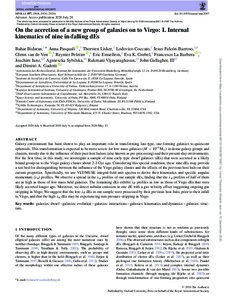On the accretion of a new group of galaxies on to Virgo: I. Internal kinematics of nine in-falling dEs
Bidaran B; Pasquali A; Lisker T; Coccato L; Falcon-Barroso J; van de Ven G; Peletier R; Emsellem E; Grebel EK; La Barbera F; Janz J; Sybilska A; Vijayaraghavan R; Gallagher J; Gadotti DA
On the accretion of a new group of galaxies on to Virgo: I. Internal kinematics of nine in-falling dEs
Bidaran B
Pasquali A
Lisker T
Coccato L
Falcon-Barroso J
van de Ven G
Peletier R
Emsellem E
Grebel EK
La Barbera F
Janz J
Sybilska A
Vijayaraghavan R
Gallagher J
Gadotti DA
OXFORD UNIV PRESS
Julkaisun pysyvä osoite on:
https://urn.fi/URN:NBN:fi-fe2021042825747
https://urn.fi/URN:NBN:fi-fe2021042825747
Tiivistelmä
Galaxy environment has been shown to play an important role in transforming late-type, star-forming galaxies to quiescent spheroids. This transformation is expected to be more severe for low-mass galaxies (M < 10(10) M-circle dot) in dense galaxy groups and clusters, mostly due to the influence of their past host haloes (also known as pre-processing) and their present-day environments. For the first time, in this study, we investigate a sample of nine early-type dwarf galaxies (dEs) that were accreted as a likely bound group on to the Virgo galaxy cluster about 2-3 Gyr ago. Considering this special condition, these nine dEs may provide a test bed for distinguishing between the influence of the Virgo galaxy cluster and the effects of the previous host halo on their current properties. Specifically, we use vr-umusF integral-field unit spectra to derive their kinematics and specific angular momentum (lambda(R)) profiles. Wc observe a spread in the lambda(R) profiles of our sample dEs, finding that the lambda(R) profiles of half of them are as high as those of low-mass field galaxies. The remaining dEs exhibit lambda(R) profiles as low as those of Virgo dEs that were likely accreted longer ago. Moreover, we detect nebular emission in one dE with a gas velocity offset suggesting ongoing gas stripping in Virgo. We suggest that the low-lambda(R) dEs in our sample were processed by their previous host halo, prior to their infall to Virgo, and that the high-lambda(R) dEs may be experiencing ram pressure stripping in Virgo.
Kokoelmat
- Rinnakkaistallenteet [27094]
